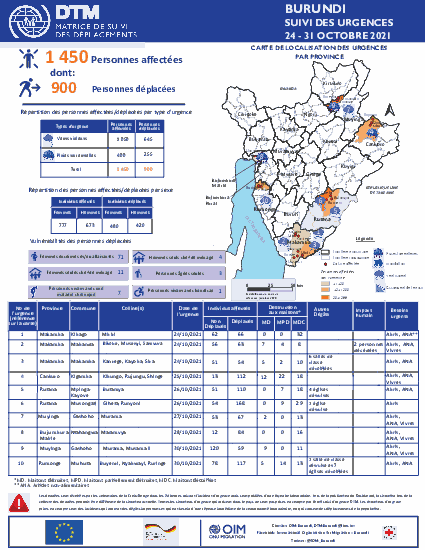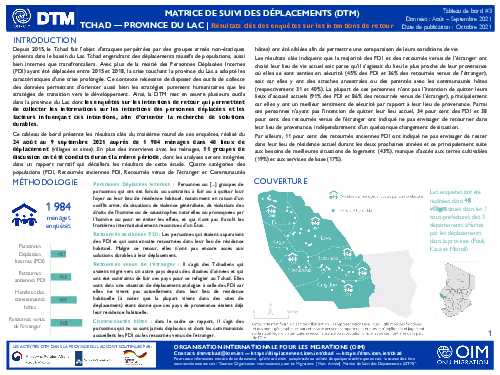-
Countries
-
Data and Analysis
-
Special Focus
-
Crisis Responses

Contact
DTMMozambique@iom.int
Language
English
Location
Mozambique
Period Covered
Oct 20 2021
Oct 26 2021
Activity
- Event Tracking
- Mobility Tracking
During the reporting period (20 to 26 October 2021), a total of 58 movements were recorded - 13 returns (909 individuals), 19 arrivals (544 individuals), 21 departures (268 individuals), and 5 transits (267 individuals), The largest returns were recorded in Nangade (743 individuals), and Mueda (104 individuals). The largest arrival was recorded in Nangade (425 individuals). The largest departure was recorded in Chiure (112 individuals). Less than half of the population (22%) were displaced for the first time. An estimated 78 per cent of reported IDPs had been displaced more than once prior to this latest movement.

Contact
DTM Burundi, DTMBurundi@iom.int
Language
French
Location
Burundi
Period Covered
Oct 24 2021
Oct 31 2021
Activity
- Event Tracking
- Mobility Tracking
Durant la semaine du 24 au 31 Octobre, 400 personnes ont été touchées par des pluies torrentielles (255 personnes déplacées) et 1050 personnes affectées par des vents violents (645 personnes déplacées).

Contact
DTM Mozambique, DTMMozambique@iom.int
Language
English
Location
Mozambique
Period Covered
Sep 14 2021
Oct 01 2021
Activity
- Mobility Tracking
- Site Assessment
From 14 September to 1 October 2021, in close coordination with Mozambique’s National Institute for Disaster Management and Risk Reduction (INGD) of Manica and Sofala, the International Organization for Migration (IOM)’s Displacement Tracking Matrix (DTM) teams conducted Multi-Sectoral Location Assessments (MSLA) in 72 sites hosting 109,275 internally displaced persons (IDPs) - 83,018 in Sofala and 26,257 in Manica - in response to the mass displacements caused by Tropical Cyclone Idai, Tropical Cyclone Eloise, Tropical Storm Chalane, floods, violence and insecurity in the Central region, and the conflict in Cabo Delgado. Of the total 109,275 individuals in the assessed sites, 26,331 (or 24%) are women, 23,673 (22%) are men, and 59,271 (54%) are children. Demographic data in Figures 2 and 3 is a sample collected through random sampling of twenty households per site.

Contact
DTM Somalia, IOMSomaliaDTM@iom.int
Language
English
Location
Somalia
Period Covered
Sep 01 2021
Sep 30 2021
Activity
- Flow Monitoring
In September 2021, a total of 25,246 movements were observed at 7 Flow Monitoring Points (FMPs). This represents an increase of 52 per cent in comparison with September 2020 (5 months after the country’s first case of COVID-19) when 16,598 movements were observed.
Doolow, Buuhoodle, Bossaso, Cabudwaaq and Lowyacado FMPs recorded an increase in movements between these two periods (190%, 60%, 45%, 39% and 2%, respectively), while Harirad and Dhobley FMPs recorded a decrease in movement (-19% and -3%, respectively).
Cabudwaaq, Doolow, Buuhoodle and Bossaso FMPs recorded the highest numbers of incoming flows (26%, 25%, 16% and 15% of all incoming flows, respectively), additionally Bossaso, Doolow and Dhobley recorded the highest numbers of outgoing flows (39%, 33% and 9% of all outgoing flows, respectively).
Contact
DTM Mozambique, DTMMozambique@iom.int
Location
Mozambique
Activity
- Site Assessment
- Mobility Tracking
Period Covered
Sep 14 2021 -Oct 01 2021
A site assessment is a sub-component of mobility tracking. It aims to collect data on population presence, living conditions and needs in a particular displacement site or community.
Population Groups
Survey Methodology
Unit of Analysis Or Observation
Type of Survey or Assessment
Keywords
Geographical Scope
Administrative boundaries with available data
The current dataset covers the following administrative boundaries

Contact
DTM Chad, dtmtchad@iom.int
Language
English
Location
Chad
Period Covered
Aug 01 2021
Sep 30 2021
Activity
- Survey
- Return Intention
Depuis 2015, le Tchad fait l’objet d’attaques perpétrées par des groupes armés non-étatiques présents dans le bassin du Lac Tchad engendrant des déplacements massifs de populations, aussi bien internes que transfrontaliers. Avec plus de la moitié des Personnes Déplacées Internes (PDI) ayant été déplacées entre 2015 et 2018, la crise touchant la province du Lac a adopté les caractéristiques d'une crise prolongée. Ce contexte nécessite de disposer des outils de collecte des données permettant d’orienter aussi bien les stratégies purement humanitaires que les stratégies de transition vers le développement. Ainsi, la DTM met en œuvre plusieurs outils dans la province du Lac dont les enquêtes sur les intentions de retour qui permettent de collecter les informations sur les intentions des personnes déplacées et les facteurs influençant ces intentions, afin d’orienter la recherche de solutions durables. Ce tableau de bord présente les résultats clés du troisième round de ces enquêtes, réalisé du 24 août au 9 septembre 2021 auprès de 1 984 ménages dans 48 lieux de déplacement (villages et sites). En plus des interviews avec les ménages, 11 groupes de discussion ont été conduits durant la même période, dont les analyses seront intégrées dans un rapport narratif qui détaillera les résultats de cette étude. Quatre catégories des populations (PDI, Retournés anciennes PDI, Retournés venus de l’étranger et Communautés hôtes) ont été ciblées afin de permettre une comparaison de leurs conditions de vie.

Contact
DTM Chad, dtmtchad@iom.int
Language
English
Location
Chad
Period Covered
Aug 01 2021
Sep 30 2021
Activity
- Survey
- Return Intention
Since 2015, there has been an increase in attacks by non-state armed groups in Chad, specifically in the Lake Chad Basin area, resulting in massive internal and cross-border displacement. The crisis affecting the Lake Province has adopted the characteristics of a protracted crisis, with more than half of Internally Displaced Persons (IDPs) having been displaced between 2015 and 2018. This context requires data collection tools to guide both humanitarian and nexus strategies. Thus, the Displacement Tracking Matrix (DTM) implements several tools in the Lake Province, including return intention surveys, which aim at collecting information on the intentions of displaced persons and the factors influencing these intentions, in order to inform the development of durable solutions.
This dashboard presents key findings from the third round of return intention surveys in the Lake Province, conducted from 24 August to 9 September 2021, with 1,984 households in 48 displacement locations (villages and sites). In addition to household interviews, 11 focus groups were conducted within the same period, whose analyses will be incorporated into a narrative report detailing the results of this study. Four categories of populations (IDPs, former IDP returnees, returnees from abroad, and host communities) were surveyed to make a comparison of their living conditions

Contact
iomisbdtmremapteam@iom.int
Language
English
Location
Pakistan
Period Covered
Sep 24 2021
Nov 06 2021
Activity
- Flow Monitoring
From 24 September to 06 November 2021, 1,834 undocumented Afghan migrants returned to Afghanistan, including 415 through the Torkham border point and 1,419 through the Chaman border point. The number of individuals who returned through the Torkham border crossing remained low as restrictions were imposed by the Pakistan Border Authorities in light of the security situation at the border with Afghanistan and the evolving COVID-19 pandemic.

Contact
DTM Pakistan, iomisbdtmremapteam@iom.int
Language
English
Location
Pakistan
Period Covered
Jul 01 2021
Sep 30 2021
Activity
- Flow Monitoring
IOM Pakistan collects data on the outflows of undocumented Afghan migrants at the Torkham and Chaman border crossing points in an effort to better understand the migration movements of undocumented Afghan migrants returning to Afghanistan from Pakistan. This report is part of the European Union funded project ‘‘Displacement Tracking Matrix Regional Evidence for Migration Analysis and Policy (DTM REMAP)”.
This edition of ‘A Region on the Move’ covers the first six months of 2021 in the East and Horn of Africa region (EHoA). The current mid-year mobility overview provides an outline of some of the main socio-political events that occurred between January and June 2021, as well as an overview of the main population movement trends that affected the region. Migration flows are of particular importance in the region, as mobility is used both as a coping mechanism and an economic engine.
